Image of the Day Archives
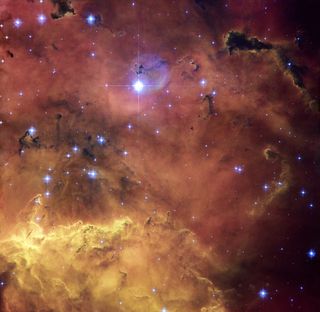
For older Image of the Day pictures, please visit the Image of the Day archives. Pictured: NGC 2467.
G’day, Eclipse

Thursday, May 1, 2014: Astrophotographer James Corker sent in a photo of the partial solar eclipse taken at a satellite farm at Perth International Telecommunications Centre located in Gnangara, north of Perth in Western Australia, on April 29, 2014. He writes in an email to Space.com: "The weather gods really had it in for this eclipse…. It was almost half an hour into the eclipse before the first break in the clouds. Until then I couldn’t even locate where to point the camera ... but I was ... finally rewarded. [The eclipse] was rarely visible for more than a few seconds at a time … "
— Tom Chao
Mars Ejecta
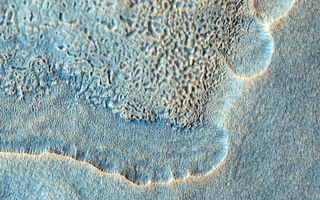
Friday, May 2, 2014: Mars Reconnaissance Orbiter (MRO) examined the edge of impact ejecta from a crater to the northwest of this area (north is up, west to the left). The ejecta visible in the top left of this image seems to sit lower than the surrounding surface, an unusual occurrence because impact ejecta falls on top of existing ground. The ejecta also seems to show pits. Could the hot ejecta have fallen on frozen ground and melted the underlying ice? Image released April 30, 2014.
— Tom Chao
Starburst
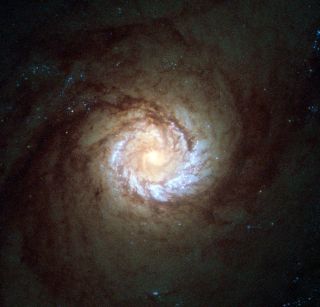
Monday, May 5, 2014: Hubble Space Telescope provides the sharpest image of the core of spiral galaxy Messier 61. The High Resolution Channel of Hubble's Advanced Camera for Surveys shows the central part of the galaxy in striking detail. This galaxy, also known as NGC 4303, stretches about 100 000 light-years across, similar in size to our galaxy, the Milky Way. Astronomers consider Messier 61 as a type of galaxy called a starburst galaxy. Starburst galaxies display an incredibly high rate of star formation, using up their reservoir of gas in a very short period of time (astronomically speaking). Also a supermassive black hole violently spewing out radiation may lie at the heart of the galaxy.
— Tom Chao
Hold on Loosely
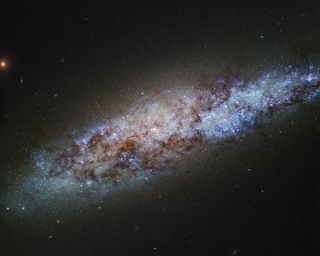
Tuesday, May 6, 2014: A dwarf spiral galaxy known as NGC 4605 lies about 16 million light-years away in the constellation of Ursa Major (The Great Bear). NGC 4605 doensn’t show its spiral structure clearly, but astronomers classify the galaxy as an SBc type meaning that it possesses sprawling, loosely wound arms and a bright bar of stars cutting through its center.
— Tom Chao
Through Quiet Reflection

Wednesday, May 7, 2014: Astrophotographer Amit Ashok Kamble sent in a photo of the Milky Way and its reflection in a pool, taken in Pakiri, New Zealand. Kamble writes in an email message to Space.com: " … out at Pakiri Beach shooting the Milky Way, I came across this pool which was unusually quiet and calm. The sky at Pakiri is so dark that the Milky Way was reflected so brilliantly in the pool. This image is a 60-sec. exposure untracked, and hence the small trails."
— Tom Chao
Dunes
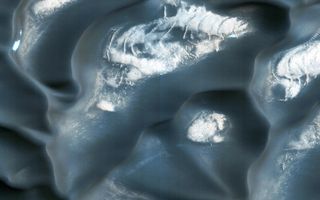
Thursday, May 8, 2014: A large field of sand dunes surrounding Mars' North Polar ice cap makes up Olympia Undae. The high latitude of the dunes causes water and carbon dioxide frost to cover them in the winter, and then the dunes have poor illumination. Best viewing comes in the summer, when features such as ripples on the dunes' surface stand out in detail. (The cap probably covers over some dunes, but we can't see them directly.) This image shows the dunes in early summer of this year. The dark material consists of sand that makes up the dunes. Between the dunes, bright bedrock and some lingering patches of frost that have not yet sublimated remain visible.
— Tom Chao
Get the Space.com Newsletter
Breaking space news, the latest updates on rocket launches, skywatching events and more!
Youth Center
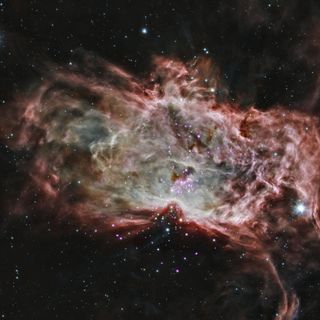
Friday, May 9, 2014: Astronomers who studied two star clusters using NASA's Chandra X-ray Observatory and infrared telescopes discovered that the simplest ideas for the birth of star clusters cannot work. This composite image shows one of the clusters, NGC 2024, which lies in the center of the “Flame Nebula,” about 1,400 light years from Earth. In this image, X-rays from Chandra appear purple, while infrared data from NASA's Spitzer Space Telescope appear red, green and blue. A study of NGC 2024 and the Orion Nebula Cluster, another region where many stars currently form, suggest that the stars on the outskirts of these clusters have an older age than those in the central regions. This finding differs from what the simplest idea of star formation predicts, where stars manifest first in the center of a collapsing cloud of gas and dust when the density grows large enough.
— Tom Chao
I Know You're Getting Twisted

Monday, May 12, 2014: A still frame from a video taken by the Solar Dynamics Observatory spacecraft on April 29, 2014, shows a small, hovering mass of twisted strands of plasma as it shifted back and forth before erupting into space. The plasma appears darker only because it has a lower temperature than the surrounding material when viewed in extreme ultraviolet light. Competing magnetic forces pulls and stretches the suspended plasma until something triggers the breakaway. This kind of activity happens fairly commonly on the sun, but this level of detail has only been available to observers since SDO began operations just four years ago.
— Tom Chao
'Bridging the Gap'
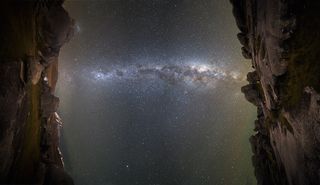
Tuesday, May 13, 2014: Astrophotographer Rob Dickinson sent in an image of the night sky that might seem disorienting at first. The photo shows a 180-degree panorama of the of the night sky, taken at Castle Hill limestone rock formations in New Zealand on May 3, 2014. This location lies in the Canterbury High Country west of the city of Christchurch in the island nation. Dickinson writes in an email message to Space.com that the image represents a "180-degree vertical panoramic stitch."
— Tom Chao
Under the Moonlight

Wednesday, May 14, 2014: Astrophotographer John Chumack sent in a photo of the waxing gibbous moon taken May 10, 2014, from his backyard observatory in Dayton, Ohio. He reminds everyone that the moon will get closer to Saturn on the evening of May 13-14. He says in an email message to Space.com: “Despite the bright moonlight, there are still many cool happenings to watch in the night sky!”
— Tom Chao
Join our Space Forums to keep talking space on the latest missions, night sky and more! And if you have a news tip, correction or comment, let us know at: community@space.com.

